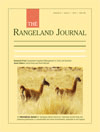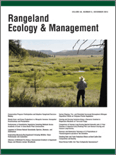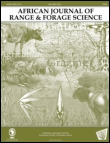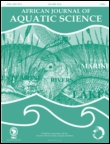
RANGELAND JOURNAL
Scope & Guideline
Unveiling Insights into Rangeland Ecology
Introduction
Aims and Scopes
- Sustainable Rangeland Management:
The journal emphasizes research aimed at sustainable practices in grazing and land management, exploring how these practices can enhance ecosystem health while meeting agricultural production needs. - Biodiversity and Ecosystem Services:
A core area of focus is the relationship between rangeland management and biodiversity, including how management practices can support ecosystem services such as carbon sequestration and soil health. - Impact of Climate Change:
Research that investigates the effects of climate change on rangelands, including shifts in vegetation, soil properties, and water resources, is a consistent theme in the journal's publications. - Use of Remote Sensing and Technology:
The journal promotes the application of remote sensing, GIS, and other technological advances to monitor and manage rangeland conditions, providing innovative methodologies for data collection and analysis. - Indigenous Knowledge and Practices:
A unique contribution of the journal is its focus on integrating Indigenous knowledge and practices in rangeland management, reflecting the cultural significance of these lands.
Trending and Emerging
- Nature-Based Solutions:
Recent publications have increasingly focused on nature-based solutions, particularly in the context of Indigenous land management, exploring how these approaches can address environmental challenges and enhance ecosystem resilience. - Remote Sensing Applications:
There is a growing trend in utilizing remote sensing technologies for monitoring and managing rangelands, indicating an increased reliance on data-driven methodologies to assess land health and productivity. - Climate Resilience and Adaptation Strategies:
Research addressing climate resilience has gained traction, focusing on adaptive management strategies that can help rangelands cope with the impacts of climate change, such as drought and altered precipitation patterns. - Policy and Governance Frameworks:
There is an emerging emphasis on the analysis of policy frameworks affecting rangeland management, highlighting the importance of governance structures in facilitating sustainable practices and addressing stakeholder needs. - Integration of Social Dynamics in Management:
Studies are increasingly considering social-identity dynamics and community engagement in rangeland management, reflecting a growing recognition of the importance of social factors in achieving effective management outcomes.
Declining or Waning
- Traditional Grazing Practices:
There has been a noticeable decrease in research focused solely on traditional grazing practices without considering innovative or sustainable adaptations, suggesting a shift toward more progressive management strategies. - Historical Land Use Studies:
Research centered on historical land use practices has waned, possibly indicating a greater emphasis on current management practices and their immediate impacts rather than retrospective analyses. - Purely Economic Perspectives:
Papers focusing solely on the economic aspects of rangeland management, without incorporating environmental or social dimensions, appear to be declining, reflecting a broader trend toward integrated approaches.
Similar Journals

Rangeland Ecology & Management
Elevating Research on Rangeland Ecosystem DynamicsRangeland Ecology & Management, published by ELSEVIER, is a leading academic journal dedicated to the interdisciplinary exploration of varied aspects of rangeland ecosystems, including their sustainable management and conservation. With an ISSN of 1550-7424 and an E-ISSN of 1551-5028, the journal has established itself as a vital resource in the fields of Animal Science and Zoology, Ecology, and Management, Monitoring, Policy and Law, achieving prominent Q1 quartile rankings in these categories as of 2023. The journal's significant Scopus rankings further attest to its impact, securing a position in the top percentiles of related fields. Published of noteworthy research from 2005 to 2024, Rangeland Ecology & Management serves not only as an academic platform but also fosters meaningful discussions on rangeland policy implications across the globe. The journal offers both subscription and Open Access options, ensuring that innovative research is readily available to researchers, professionals, and students passionate about ecology and sustainable practices. Join the Rangeland Ecology & Management community and contribute to advancing our understanding of rangeland ecosystems.

Acta Scientiarum Polonorum-Formatio Circumiectus
Connecting global minds to protect our planet.Acta Scientiarum Polonorum-Formatio Circumiectus is a distinguished open-access journal published by WYDAWNICTWO UNIWERSYTETU ROLNICZEGO HUGONA KOLLATAJA KRAKOWIE, dedicated to advancing knowledge in the fields of ecological modeling, environmental engineering, nature and landscape conservation, and water science and technology. With a commitment to accessibility since its inception in 2006, this journal provides a platform for researchers, professionals, and educators to disseminate their findings to a global audience. Although currently categorized in the Q4 quartile across various ecological disciplines, the journal's aim is to foster critical discussions and innovative approaches to pressing environmental challenges. The journal is based in Poland, and its scope encompasses a wide array of research areas pertinent to contemporary environmental studies. Acta Scientiarum Polonorum serves as an essential resource in its field, encouraging empirical research and theoretical advancements that collectively contribute to sustainable development and environmental stewardship.

WETLANDS
Fostering Collaboration for Ecological ExcellenceWETLANDS is a prestigious academic journal dedicated to advancing the understanding of wetland ecosystems, published by SPRINGER and based in the Netherlands. Established in 1981, this journal has consistently offered high-quality research on ecological dynamics, environmental chemistry, and broader environmental science topics, as indicated by its notable rankings in the 2023 category quartiles: Q2 in Ecology and Environmental Science (miscellaneous) and Q3 in Environmental Chemistry. The journal impacts the scientific community significantly, as reflected in its Scopus rankings, which place it within the top percentiles of its field. This makes WETLANDS an essential resource for researchers, professionals, and students aiming to stay at the forefront of wetland research and conservation efforts. With continual contributions from experts worldwide, it not only disseminates critical findings but also fosters collaboration and innovation within this vital area of environmental science.

AFRICAN JOURNAL OF RANGE & FORAGE SCIENCE
Driving Ecological Understanding Across the African LandscapeAFRICAN JOURNAL OF RANGE & FORAGE SCIENCE is a premier scholarly publication dedicated to the fields of animal science, zoology, and ecology, published by TAYLOR & FRANCIS LTD. With a notable impact factor and categorized in the Q2 quartile for both Animal Science and Ecology, this journal is essential for disseminating cutting-edge research that addresses the complexities of forage management and its ecological implications across the African continent. Established in 1993 and continuing to engage with the latest advancements through to 2024, it serves as a vital platform for researchers, practitioners, and students to share innovative findings and practical applications. The journal not only fosters collaboration among scientists but also emphasizes the importance of sustainable practices in range management, providing insights that have broader implications for environmental conservation. Although it is not currently open access, the journal remains a respected entity in academic circles, with Scopus rankings reflecting its significant contribution to the scientific community. Readers are encouraged to explore its rich repository of research to inform and inspire future studies in these crucial areas.

Sylwan
Fostering sustainable development in forestry across Europe.Sylwan, published by POLSKIE TOWARZYSTWO LESNE, is a key journal in the field of forestry, focusing on the science and practice of sustainable forest management and conservation. Operating since 1979 and releasing issues periodically, including those from 2011 to 2018 and from 2020 to 2024, this journal plays a vital role in disseminating research and advances in forestry practices particularly relevant to Poland and the broader European context. While currently not offering open access options, Sylwan maintains a Q4 ranking in the forestry category according to the Scopus database, highlighting its dedicated niche within the scientific community. The journal serves as an essential resource for researchers, professionals, and students seeking to enhance their understanding of forestry issues in a global and ecological framework. With a commitment to promoting innovative research, Sylwan supports the ongoing dialogue on forestry management and policies, ultimately contributing to the sustainable development of forest resources.

EQA-International Journal of Environmental Quality
Exploring the nexus of human activity and environmental health.EQA-International Journal of Environmental Quality, published by the University of Bologna, Department of Agricultural Sciences, is a premier open-access journal dedicated to the multidisciplinary exploration of environmental quality issues. Established in 2009, it aims to foster a greater understanding of the intricate interactions between human activities and environmental health. With a focus on innovative research, the journal contributes to the advancement of knowledge across diverse fields, making it an essential resource for researchers, professionals, and students engaged in environmental science and sustainability. The journal operates with an emphasis on accessibility, ensuring that critical findings reach a global audience without barriers. With an impressive Scopus rank of 88 out of 171, EQA stands as a significant platform for disseminating impactful research that informs policy and promotes environmental stewardship.

Ecological Indicators
Empowering research for informed environmental decision-making.Ecological Indicators, published by Elsevier, is a prestigious journal dedicated to advancing the fields of ecology and environmental science. With an impressive impact factor and ranked in the Q1 quartile for both Ecology and Decision Sciences categories, the journal serves as a vital resource for researchers and professionals aiming to apply ecological knowledge to real-world problems. The journal covers a broad scope of topics within ecological indicators, aiming to provide comprehensive insights into biodiversity, ecosystem health, and sustainability metrics. Founded in 2001 and continuing through 2024, Ecological Indicators has established itself as a leader in disseminating significant research and innovative findings. The journal's standing is reflected in its remarkable Scopus ranks, placing it among the top percentile in its respective categories. Authors are encouraged to submit their work to share vital findings with an engaged audience of researchers, professionals, and dedicated students, ensuring the continued relevance and impact of ecological research on global environmental policies and practices.

Range Management and Agroforestry
Innovating Practices for Sustainable Land UseRange Management and Agroforestry, published by the RANGE MANAGEMENT SOC INDIA, is a pivotal journal dedicated to the advancing fields of range management, agroforestry, and sustainable agricultural practices. With an ISSN of 0971-2070, this journal has carved out a niche for itself within key Agricultural Sciences categories, achieving a commendable Q2 ranking in Forestry and Q3 in both Agronomy & Crop Science and Food Science as of 2023. It serves as a vital platform for researchers, professionals, and students to disseminate and access innovative research findings that address the pressing challenges in land management, biodiversity conservation, and food security. Spanning a convergence of years from 2009 to 2024, the journal provides insights into practical applications and theoretical advancements in managing grasslands and agroforestry systems, further emphasizing the role of interdisciplinary approaches in tackling ecological and agricultural issues. With a focus on enhancing knowledge within India and beyond, Range Management and Agroforestry is instrumental in fostering collaboration and communication among scholars striving for sustainable solutions in a rapidly changing environment.

Trees Forests and People
Bridging Ecosystems and Communities for a Greener FutureTrees, Forests and People is an esteemed peer-reviewed journal published by Elsevier that commenced its journey in 2020 and focuses on the intricate relationships between trees, forests, and human communities. With its E-ISSN of 2666-7193, this journal serves as a vital platform for presenting cutting-edge research in disciplines such as forestry, environmental science, and management. Recognized for its impact within the academic community, it has achieved a prestigious Q1 ranking in both Economics, Econometrics and Finance (Miscellaneous) and Forestry, alongside a Q2 ranking in Management, Monitoring, Policy and Law as of 2023. Its Scopus rankings indicate robust positioning in various fields, appealing to a diverse audience of researchers, professionals, and policy-makers engaged in sustainable forest management and ecosystem services. By offering open access options, the journal ensures that critical findings are readily available to a global audience, fostering knowledge sharing and collaborative efforts aimed at addressing the pressing challenges in forest conservation and management.

AFRICAN JOURNAL OF AQUATIC SCIENCE
Navigating the complexities of aquatic ecosystems together.AFRICAN JOURNAL OF AQUATIC SCIENCE, published by TAYLOR & FRANCIS LTD, is a premier scholarly journal dedicated to the field of aquatic science, ecology, and environmental management, playing a crucial role in advancing research and knowledge in these vital areas. With an impressive Q2 ranking in both Aquatic Science and Ecology, Evolution, Behavior and Systematics, the journal seeks to publish high-quality research encompassing a wide range of topics related to freshwater and marine ecosystems, including biodiversity, conservation strategies, and the impacts of climate change. Featuring a rich history of publication from 2000 to 2024, the journal not only embraces rigorous peer review but also aims to foster collaboration and dialogue among researchers, practitioners, and students interested in aquatic environments. Readers will find that the journal’s commitment to impactful scientific communication is reflected in its notable rankings within the Scopus database, making it an essential resource for those engaged in aquatic research and management.